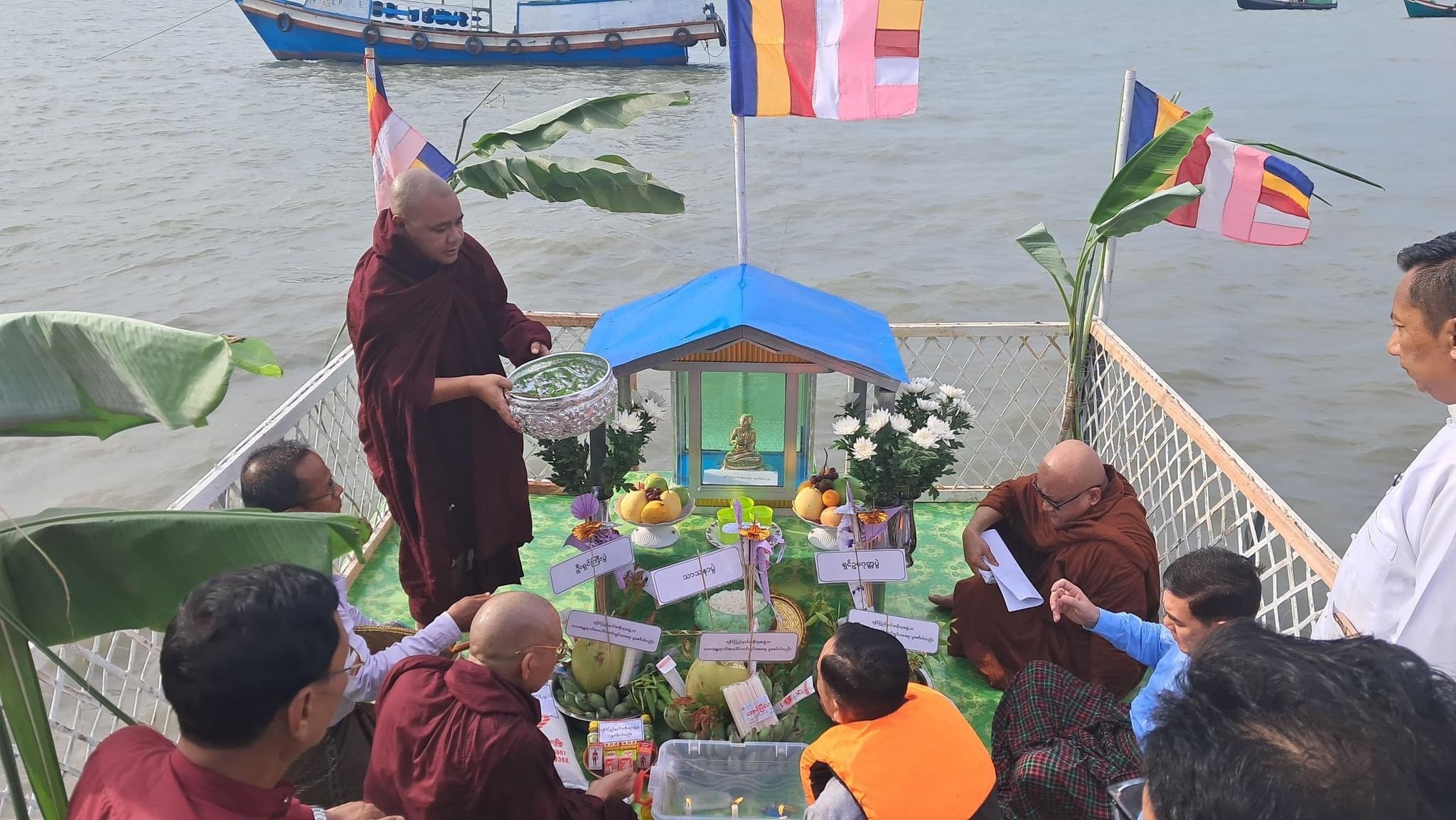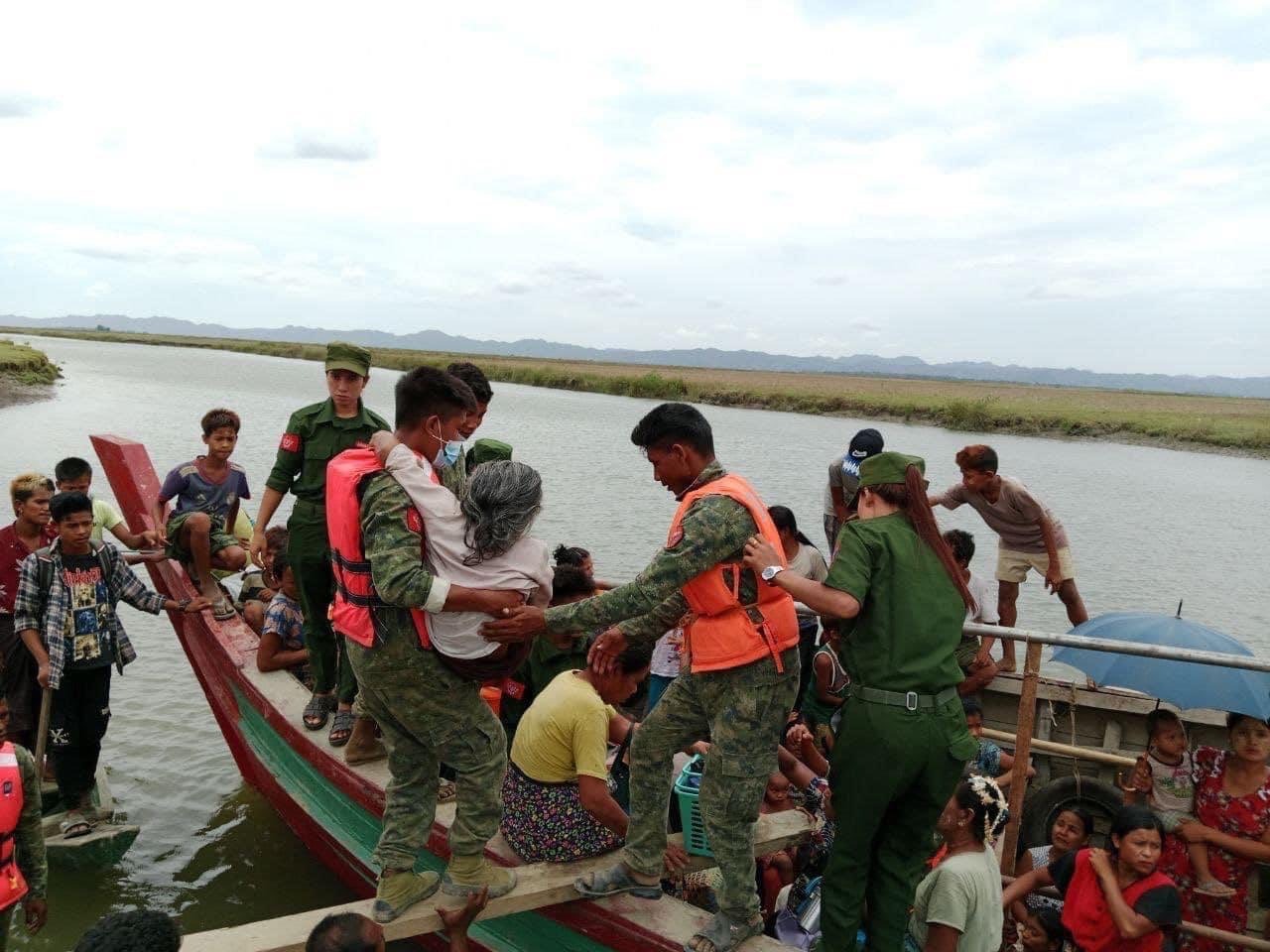Following the arrival of Cyclone Mocha last week, in western Myanmar, the humanitarian situation on the ground is dire. As of May 16, two days after the storm made landfall, approximately 1.5 million people in Rakhine were believed to have been affected by the storm and more than 400,000 buildings including hospitals, schools, and internally displace person (IDP) camps were partially or completely damaged. More than 400 people are reportedly dead, and hundreds remain missing.
Cyclone Mocha, the biggest storm to hit the region in more than a decade, made landfall at noon on May 14 between the Rakhine State capital of Sittwe and Cox’s Bazar in Bangladesh, lashing the region with winds of up to 250 kilometers per hour.
Prior to Mocha’s devastation, Rakhine State, which borders Bangladesh to the west, was relatively peaceful, unlike other parts of Myanmar, which are now in the grip of an escalating war between the military junta and those opposing its rule. Large parts of the state are under the de facto control of the rebel government led by the United League of Arakan (ULA), a Rakhine ethnic revolutionary organization, and its armed wing, the Arakan Army (AA). Formed in 2009 with the goal of greater autonomy for the people of Rakhine State, the AA is one of the country’s most powerful ethnic armed groups, counting some 30,000 people under arms, mainly present in Rakhine.
The ULA/AA has taken advantage of the chaos unleashed by the February 2021 military coup to consolidate its control over Rakhine, establishing military bases and parallel administrative and judiciary mechanisms across the regions under its control. Six months after the coup, the ULA/AA’s Arakan People’s Government (APG) claimed that it had de facto control over two-thirds of the state, including large swathes of northern and central rural areas of Rakhine, while making administrative headway in urban areas.
Differing Responses to Cyclone Mocha
The APG’s response to the humanitarian emergency that followed the arrival of Cyclone Mocha demonstrates the extent to which it now exercises political and administrative authority in Rakhine State. On May 7, the ULA warned the people of Rakhine State about the advance of Cyclone Mocha, and to prepare accordingly. The Humanitarian and Development Coordination Office, part of the APG administration, subsequently released a series of “do and don’t” pamphlets, along with the slogan “listen, alert, and prepare.”
Two days later, the ULA announced areas that were likely to be severely be affected by the cyclone, and began evacuating the residents, including Rohingya and other minorities, from the regions of Myabone, Pauktaw, Minbya, Taungok, Buthidaung, Maungdaw, Rathedaung, and Mrauk-U townships under its control. For those who chose shelter in place, the ULA also provided “do and don’t” pamphlets. On May 13, ULA spokesperson Khaing Thuka told the local news that the ULA/AA had evacuated more than 102,000 residents from these townships within five days, while calling on international organizations to assist the people.
In contrast, human rights activists and Rakhine netizens have criticized the junta officials in Rakhine for their lack of preparations for the Cyclone Mocha’s arrival. In particular, the junta has been accused of neglecting the tens of thousands of Rohingya Muslims under its control, confined to the cluster of IDP camps in western Sittwe township. (U.N. agencies and international NGOs have also been criticized for their lack of preparedness.)
Indeed, junta officials seemed more interested in conducting religious rituals in order to ward off the storm. For example, on May 12, three Buddhist monks and members of the junta’s Rakhine State administration held a ceremony on the Bay of Bengal in a bid to divert the cyclone. Likewise, The Irrawaddy reported the following day that a group of junta officials led by Ayeyarwady Region Chief Minister Tin Maung Win and southwestern command chief Brig. Gen. Kyi Khaing conducted a dragon feeding rite as a part of preparation for its arrival.

Buddhist monks and members of the Myanmar military government’s administration in Rakhine State hold a ceremony on the Bay of Bengal in a bid to divert Cyclone Mocha, May 12, 2023. (Facebook/Shwe Zeddy).
The military administration also sought to undermine the ULA/AA’s preparations for the arrival of the storm. On May 9, around 10 junta soldiers destroyed the cyclone awareness posters erected by the ULA in Zinchaung village, in Kyaukphyu township.
A day after the cyclone made landfall, the people under ULA/AA control were believed to be relatively safe, and to have experienced fewer casualties, while the Rohingya camps in Sittwe under junta control are now believed to have confirmed more than 400 deaths, while hundreds more people are missing.
Aiding the Survivors
The ULA/AA’s response to the aftereffects of the storm offers a similarly stark contrast to the junta’s sclerotic efforts. Roads that were blocked by trees downed during the storm have been cleaned by uniformed AA soldiers and residents. On May 15, the ULA called for humanitarian assistance and immediate help from leading countries and other international organizations, including shelter, food, medicine, and other basic needs. The same day, ULA government’s Humanitarian and Development Coordination Office also urged civil society organizations, U.N. agencies, and international NGOs to work together in response to the cyclone’s destruction.
On May 16, Major General Twan Mrat Naing, the AA’s commander in chief, released a short video seeking support from civil society organizations and INGOs to provide shelter, drinking water, food, and medicine to storm-hit communities in cooperation with the APG. The following day, the ULA announced the formation of the Emergency Relief and Rehabilitation Committee. Meanwhile, the AA thanked the opposition National Unity Government (NUG), the Kachin Independence Organization (KIO), and the Myanmar National Democratic Alliance Army (MNDAA) for their donations. The KIO donated 300 million kyats, while the NUG and the MNDAA donated 100 million each.
In comparison, the leader of the military junta, Senior General Min Aung Hlaing, visited Sittwe on May 15 along with some of his ministers, bringing in some humanitarian support by air, including rice, cooking oil, salt, and noodles, but it is so far unclear where this assistance has been sent. And community donors who are seeking to deliver aid from the rest of the country are not being allowed to enter the affected areas without the junta’s approval.
Meanwhile, the U.N. and its partners have faced restrictions from the junta regime, and have been unable to deliver humanitarian aid to storm-hit areas beyond the state capital. In order to access these affected areas, the U.N. refugee agency country director for Myanmar, Noriko Takagi, on May 16 presented her credentials to the junta’s Foreign Minister Than Swe in Naypyidaw and then met with Ko Ko Hlaing, the international cooperation minister. Likewise, the country director of the U.N. World Food Program met with the junta foreign ministry in the capital on May 18, in order to discuss cooperation in the delivery of aid to those impacted by the cyclone.
The Junta’s Potential to Politicize the Crisis
On the ground, many of those affected by Cyclone Mocha are now suffering due lack of humanitarian aid such as shelter, food, and medicine. Meanwhile, storm-induced flooding has contaminated water sources in several townships including Sittwe, Pauktaw, and Rathedaung, causing drinking water shortages.
Despite possessing resources such as food, shelter, and medicines, the ability of U.N. agencies and INGOs to operate in cyclone-affected areas depends on the junta’s consent. To date, there has been no guarantee that the junta leaders are willing to grant this. This is just the latest case in which the junta authority has restricted humanitarian aid shipments.

Arakan Army soldiers help evacuate villagers, including Rohingya and other minorities, from areas in the path of Cyclone Mocha. (Photo Supplied)
Given that the junta is likely to attempt to use the current crisis for political gain, U.N. and other international assistance actors need to have a Plan B. Although neighboring countries like India are providing some humanitarian assistance, there is no guarantee that this aid will get to the people who are in need in the rural areas. As observers and human rights activists have argued since the coup, foreign governments and U.N. organizations need to seriously reconsider their reliance on the brutal junta leaders for delivering aid before the situations are getting worse. This current natural disaster should not turn into a “man-made disaster” in which thousands of people starve and lose their lives.
This is as good a time as any for U.N. agencies and their INGO and NGO partners to review their policy of engagement with the country’s brutal military rulers. These agencies should recognize the ULA/AA’s capacity and effective efforts to react to the current humanitarian crisis, but also the fact that it lacks the resources to address the needs of the displaced fully, and work closely with it on emergency rescue and resettlement. Together, the two sides are in a good position to address the most pressing humanitarian needs, and ensure Myanmar’s military doesn’t prolong the suffering of those in affected areas.
Arakan Rebel Government Takes Lead in Myanmar Cyclone Recovery
Source: Frappler

0 Comments